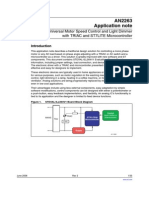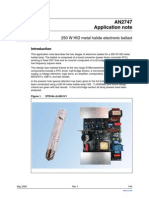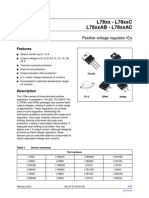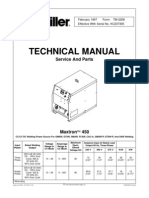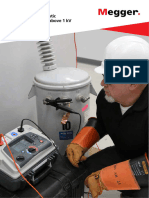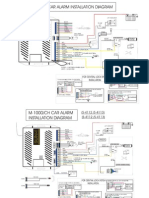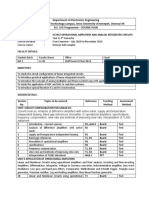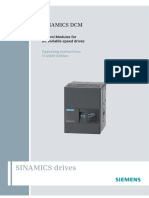Viper 12 A
Viper 12 A
Uploaded by
Marcos STCopyright:
Available Formats
Viper 12 A
Viper 12 A
Uploaded by
Marcos STOriginal Title
Copyright
Available Formats
Share this document
Did you find this document useful?
Is this content inappropriate?
Copyright:
Available Formats
Viper 12 A
Viper 12 A
Uploaded by
Marcos STCopyright:
Available Formats
AN2272 Application Note
VIPer12A-based Low Power AC/DC Adapter
Introduction
This application note describes a low power, (output power of 4.1W) general purpose adapter which is able to handle a wide range input voltages (88VAC to 265VAC). The adapter (Order Code STEVAL-ISA011V1) is based on the Viper12A monolithic device that has the power switch as well as the basic control function needed to implement a current mode flyback converter.
February 2006
Rev. 1
1/33
www.st.com
Table of Contents
AN2272 - Application Note
Table of Contents
1 STEVAL-ISA011V1 Board Design . . . . . . . . . . . . . . . . . . . . . . . . . . . . . . 5
1.1 Primary Side . . . . . . . . . . . . . . . . . . . . . . . . . . . . . . . . . . . . . . . . . . . . . . . . 5
1.1.1 1.1.2 Step 1, Input Capacitor Selection . . . . . . . . . . . . . . . . . . . . . . . . . . . . . . 5 Step 2, Transformer Selection . . . . . . . . . . . . . . . . . . . . . . . . . . . . . . . . . 6
1.2
Secondary Side . . . . . . . . . . . . . . . . . . . . . . . . . . . . . . . . . . . . . . . . . . . . . 8
1.2.1 1.2.2 1.2.3 D11 Current and Power Dissipation . . . . . . . . . . . . . . . . . . . . . . . . . . . . . 9 Transformer Turns Ratio and D11 Peak Current . . . . . . . . . . . . . . . . . . . 10 C11 Output Capacitor Selection . . . . . . . . . . . . . . . . . . . . . . . . . . . . . . . 11
1.3 1.4
Completed Transformer Design . . . . . . . . . . . . . . . . . . . . . . . . . . . . . . . . 12 Feedback Loop . . . . . . . . . . . . . . . . . . . . . . . . . . . . . . . . . . . . . . . . . . . . . 12
STEVAL-ISA011V1 Board Tests . . . . . . . . . . . . . . . . . . . . . . . . . . . . . . . 15
2.1 Start-up Tests . . . . . . . . . . . . . . . . . . . . . . . . . . . . . . . . . . . . . . . . . . . . . . 15
2.1.1 2.1.2 Full Load Start-up Waveforms . . . . . . . . . . . . . . . . . . . . . . . . . . . . . . . . 16 No Load Start-up Waveforms . . . . . . . . . . . . . . . . . . . . . . . . . . . . . . . . 18
2.2 2.3 2.4
Temperature Tests . . . . . . . . . . . . . . . . . . . . . . . . . . . . . . . . . . . . . . . . . . 20 Dynamic Load Regulation Tests . . . . . . . . . . . . . . . . . . . . . . . . . . . . . . . . 20 Steady-State Tests . . . . . . . . . . . . . . . . . . . . . . . . . . . . . . . . . . . . . . . . . . 23
2.4.1 2.4.2 Steady-State Full Load Waveforms . . . . . . . . . . . . . . . . . . . . . . . . . . . . 24 Steady-State No Load Waveforms . . . . . . . . . . . . . . . . . . . . . . . . . . . . . 26
2.5
EMI Tests . . . . . . . . . . . . . . . . . . . . . . . . . . . . . . . . . . . . . . . . . . . . . . . . . 28
Appendix A STEVAL-ISA011V Demo Board Schematic . . . . . . . . . . . . . . . . . . . 30 Appendix B STEVAL-ISA011V1 Bill of Materials . . . . . . . . . . . . . . . . . . . . . . . . . 31 3 Revision History . . . . . . . . . . . . . . . . . . . . . . . . . . . . . . . . . . . . . . . . . . . 32
2/33
Rev. 1
AN2272 - Application Note
List of Figures
List of Figures
Figure 1. Figure 2. Figure 3. Figure 4. Figure 5. Figure 6. Figure 7. Figure 8. Figure 9. Figure 10. Figure 11. Figure 12. Figure 13. Figure 14. Figure 15. Figure 16. Figure 17. Figure 18. Figure 19. Figure 20. Figure 21. Figure 22. Figure 23. Figure 24. Figure 25. Full Load Start-up Waveforms at 88V. . . . . . . . . . . . . . . . . . . . . . . . . . . . . . . . . . . . . . . . . 16 Full Load Start-up Waveforms at 265V. . . . . . . . . . . . . . . . . . . . . . . . . . . . . . . . . . . . . . . . 16 Full Load Start-up Waveforms at 115V. . . . . . . . . . . . . . . . . . . . . . . . . . . . . . . . . . . . . . . . 17 Full Load Start-up Waveforms at 230V. . . . . . . . . . . . . . . . . . . . . . . . . . . . . . . . . . . . . . . . 17 No Load Start-up Waveforms at 88V . . . . . . . . . . . . . . . . . . . . . . . . . . . . . . . . . . . . . . . . . 18 No Load Start-up Waveforms at 265V . . . . . . . . . . . . . . . . . . . . . . . . . . . . . . . . . . . . . . . . 18 No Load Start-up Waveforms at 115V . . . . . . . . . . . . . . . . . . . . . . . . . . . . . . . . . . . . . . . . 19 No Load Start-up Waveforms at 230V . . . . . . . . . . . . . . . . . . . . . . . . . . . . . . . . . . . . . . . . 19 Step Load Change Stability Tests at 88V . . . . . . . . . . . . . . . . . . . . . . . . . . . . . . . . . . . . . . 21 Step Load Change Stability Tests at 265V . . . . . . . . . . . . . . . . . . . . . . . . . . . . . . . . . . . . . 21 Step Load Change Stability Tests at 115V . . . . . . . . . . . . . . . . . . . . . . . . . . . . . . . . . . . . . 22 Step Load Change Stability Tests at 230V . . . . . . . . . . . . . . . . . . . . . . . . . . . . . . . . . . . . . 22 Steady-state Full Load 88VAC Waveforms . . . . . . . . . . . . . . . . . . . . . . . . . . . . . . . . . . . . . 24 Steady-state Full Load 265V AC Waveforms . . . . . . . . . . . . . . . . . . . . . . . . . . . . . . . . . . . . 24 Steady-state Full Load 115V AC Waveforms . . . . . . . . . . . . . . . . . . . . . . . . . . . . . . . . . . . . 25 Steady-state Full Load 230V AC Waveforms . . . . . . . . . . . . . . . . . . . . . . . . . . . . . . . . . . . . 25 Steady-state No Load 88V AC Waveforms . . . . . . . . . . . . . . . . . . . . . . . . . . . . . . . . . . . . . 26 Steady-state No Load 265V AC Waveforms . . . . . . . . . . . . . . . . . . . . . . . . . . . . . . . . . . . . 26 Steady-state No Load 115V AC Waveforms . . . . . . . . . . . . . . . . . . . . . . . . . . . . . . . . . . . . 27 Steady-state No Load 230V AC Waveforms . . . . . . . . . . . . . . . . . . . . . . . . . . . . . . . . . . . . 27 115VAC Line Voltage. . . . . . . . . . . . . . . . . . . . . . . . . . . . . . . . . . . . . . . . . . . . . . . . . . . . . . 28 115VAC Line Neutral . . . . . . . . . . . . . . . . . . . . . . . . . . . . . . . . . . . . . . . . . . . . . . . . . . . . . . 28 230VAC Line Voltage. . . . . . . . . . . . . . . . . . . . . . . . . . . . . . . . . . . . . . . . . . . . . . . . . . . . . . 29 230VAC Line Neutral . . . . . . . . . . . . . . . . . . . . . . . . . . . . . . . . . . . . . . . . . . . . . . . . . . . . . . 29 STEVAL-ISA011V1 Schematic . . . . . . . . . . . . . . . . . . . . . . . . . . . . . . . . . . . . . . . . . . . . . . 30
Rev. 1
3/33
List of Tables
AN2272 - Application Note
List of Tables
Table 1. Table 2. Table 3. Table 4. Table 5. Table 6. Table 7. Electrical Characteristics . . . . . . . . . . . . . . . . . . . . . . . . . . . . . . . . . . . . . . . . . . . . . . . . . . 15 Start up Measures . . . . . . . . . . . . . . . . . . . . . . . . . . . . . . . . . . . . . . . . . . . . . . . . . . . . . . . 15 Component Critical Temperature Measurements . . . . . . . . . . . . . . . . . . . . . . . . . . . . . . . . 20 Steady-state Full Load Condition Measurements . . . . . . . . . . . . . . . . . . . . . . . . . . . . . . . . 23 Steady-state Output Voltage Ripple . . . . . . . . . . . . . . . . . . . . . . . . . . . . . . . . . . . . . . . . . . 23 Bill Of Materials. . . . . . . . . . . . . . . . . . . . . . . . . . . . . . . . . . . . . . . . . . . . . . . . . . . . . . . . . . 31 Document revision history . . . . . . . . . . . . . . . . . . . . . . . . . . . . . . . . . . . . . . . . . . . . . . . . . 32
4/33
Rev. 1
AN2272 - Application Note
STEVAL-ISA011V1 Board Design
STEVAL-ISA011V1 Board Design
In order to improve regulation, the feedback loop is designed to have enough bandwidth so the converter can react on time to load changes. As is shown in the Section 2.3: Dynamic Load Regulation Tests on page 20, the board is able to handle high load step changes with very low variations in the output voltage. The flyback converter is designed to work in Discontinuous Conduction Mode (DCM) in all operating conditions (i.e. Minimum Input Voltage, Maximum Load), because it provides better dynamic performance.
1.1
1.1.1
Primary Side
Step 1, Input Capacitor Selection
The first design step is to calculate the input capacitor value (C2a + C2b see STEVALISA011V Demo Board Schematic on page 30). Equation 1 is useful for this purpose: Equation 1 2 P IN T C IN = ----------------------------------------------------------------2 2 V AC ( min )pk V DC ( m in ) Where, CIN = input capacitor value, PIN = input power, T = the time between the two conduction cycles of the input bridge diodes, VAC(min)pk = sinusoidal input waveform peaks (when AC voltage is at its minimum), and VDC(min) = selected minimum input voltage required for the flyback (converter) stage. In this case, the PIN value used is calculated as PO/, where PO is the maximum output power and is the overall expected efficiency (70% in this example).
Rev. 1
5/33
STEVAL-ISA011V1 Board Design An acceptable value for VDC(min) is 80% of VAC(min)pk: Equation 2 V DC ( min ) = 0.8VAC ( min ) pk = T is expressed as: Equation 3
AN2272 - Application Note
2V AC ( min )
V DC ( min ) 1 T = ------------------------- arc cos ----------------------------- V AC ( m in )pk 2 f line Where, T = the time between the two conduction cycles of the input bridge diodes, and fline = line frequency. The calculated value of C IN using Equation 1 is 16F. For the board, two capacitors (C2a and C2b, see STEVAL-ISA011V Demo Board Schematic on page 30) of 10F were used. This means that C IN = 20F. This value was selected because the tolerance for an electrolytic capacitor is usually around 20%.
1.1.2
Step 2, Transformer Selection
The next step is selecting a transformer with a Primary Inductance (LP) that allows the system to work at the boundary between Continuous Conduction Mode (CCM) and Discontinuous Conduction Mode (DCM). The worst case is minimum input voltage and full load. This value is expressed as: Equation 4
( V DC ( min ) D M AX) LMAX = -------------------------------------------------------------- LMAX = 3.5mH 2 P IN f SW 2
Where, LMAX = maximum inductance for discontinuous mode operation, VDC(min) = selected minimum input voltage required for the flyback (converter) stage, DMAX = maximum duty cycle, PIN = input power, fSW = switching frequency (internally fixed in the VIper12A to 60kHz), and VR = reflected voltage (fixed to 90V).
6/33
Rev. 1
AN2272 - Application Note
STEVAL-ISA011V1 Board Design
The DMAX at the boundary between CCM and DCM is expressed as: Equation 5 VR D MAX = --------------------------------------------- D M AX = 0.47 V DC ( m in ) + V R The transformer selected for this application provides an LP of 3mH, which is a little less than the maximum inductance (LMAX) calculated in the first equation (3.5mH). This ensures that the system is not working at boundary and will always function in DCM. Using the transformers LP, the designer can calculate the:
Peak Primary Current, expressed as,
Equation 6 I PEAK = Where, IPEAK = peak primary current, PIN = input power, fSW = switching frequency, and LP = primary inductance.
2 PIN ------------------------ I PEAK f SW LP
= 258mA
actual Maximum Duty Cycle (DMAX), expressed as,
Equation 7 2 P IN f SW L P D M AX = ------------------------------------------------- D MAX = 0.42 f SW L P and
the primary side Root Mean Square (RMS) current value (IPRMS(max)), which is the current that flows through the main switch and primary winding. It is expressed as:
Equation 8 D MAX I PRM S ( max ) = I PEAK ------------------- I PRMS ( max ) = 97mA 3 Where, IPRMS(max) = Primary Current root mean square,
Rev. 1
7/33
STEVAL-ISA011V1 Board Design
AN2272 - Application Note
The conduction losses in the main switch depend on the VIPer12A IPRMS(max) and ON resistance, and are expressed as: Equation 9 P VIPer12A = r ds ( on ) I PRMS ( m ax ) Where, PVIPer12A = VIPer12A conduction losses, and rds(on) = VIPer12A ON resistance.
2
1.2
Secondary Side
In order to select the output rectifier (secondary) diode D11 , the designer needs to know the maximum reverse voltage that the diode has to sustain, as well as the average and root mean square of the current flowing through it (see STEVAL-ISA011V1 Schematic on page 30). VR(max) is calculated as follows: Equation 10 V O UT V R ( max ) = V OUT + ------------------ V DC ( m ax ) VR Where, VR(max) = maximum reverse voltage, VOUT = output voltage, VR = reflected voltage, and VDC(max) = selected maximum input voltage. A commonly used selection method is to choose a diode with a 40% to 50% safety margin from the value given by the VR(max) calculation when a Schottky diode is used, or a safety margin of 20% to 30% if a standard fast diode is used. The safety margin prevents diode breakdown from oscillation caused by circuit parasitic elements (e.g. transformer secondary inductance leakage or parasitic diode capacitance) when the MOSFET is turned ON. If the calculated VR(max) is 23V and a Schottky diode is used (adding a 50% safety margin), the D 11 value is about 34V. This makes the STPS340U (with 40V breakdown voltage) an excellent choice for this application.
8/33
Rev. 1
AN2272 - Application Note
STEVAL-ISA011V1 Board Design
1.2.1
D11 Current and Power Dissipation
The average current flowing through D11 is the output current while the IDRMS value is expressed as:
Equation 11 D s cond I DRMS = I PKS -------------------3 Where, IDRMS = current root mean square, IPKS = peak current at secondary winding, and Ds_cond = conduction duty cycle of the secondary diode. For one output flyback, IPKS (peak current at the secondary winding) can be calculated as the primary peak current multiplied by the turns ratio. Note: This formula applies only to DCM operation.
D11 power dissipation is calculated as follows:
Equation 12 P los sD = V dD I D ( avg ) + r dD I DRMS Where, PlossD = diode power dissipation, VdD = drop voltage (when the diode is forward-biased), ID(avg) = diode average current, and rdD = dynamic resistance. Note: The formula and the correct values for VdD and r dD are in the diode datasheets.
2
Rev. 1
9/33
STEVAL-ISA011V1 Board Design
AN2272 - Application Note
1.2.2
Transformer Turns Ratio and D11 Peak Current
The turns ratio that is selected for the transformer depends on the output voltage, the chosen reflected voltage, and the average voltage drop across the output diode. Keeping in mind the voltage drop across its dynamic resistance, VDROP(avg) is expressed as:
Equation 13 V DROP ( avg ) = V dD + r dD IO Where, VDROP(avg) = average voltage drop (across the output diode) VdD = drop voltage (when the diode is forward-biased), rdD = dynamic resistance, IO = diode output current, and
Using the calculated VDROP(avg) value, the turns ratio is expressed as:
Equation 14 VR NP ------- = --------------------------------------------NS V O + V DRO P ( avg ) Where, NP = Primary Turns, NS = Secondary Turns, VR = reflected voltage, and VO = output voltage.
Using the calculated turns ratio, IPKS is then expressed as:
Equation 15 NP I PKS = ------ I PKP NS Where, IPKS = peak current at secondary winding, and IPKP = peak power current Note: The worst case (maximum power dissipation) will be in full load condition.
The D11 conduction duty cycle is expressed as:
Equation 16 I PKP LP f SW D s co nd = -------------------------------------------VR Where, Ds_cond = Secondary Diode conduction duty cycle, LP = primary inductance, and fSW = switching frequency.
10/33 Rev. 1
AN2272 - Application Note
STEVAL-ISA011V1 Board Design
1.2.3
C11 Output Capacitor Selection
The output capacitor selection (C 11, see STEVAL-ISA011V1 Schematic on page 30) depends on the output voltage ripple specification (VO = 300mV), and the ripple current rate of the capacitor itself. The output voltage ripple is mainly due to the Equivalent Series Resistor (ESR), so we have to select a capacitor with an ESR lower than the maximum allowed ESR value: Equation 17 V O ESR MAX = -------------I PKS Where, ESR MAX = maximum allowed ESR rating, VO = output voltage ripple, and IPKS = peak current at secondary winding. The AC component of the current flowing through the output diode is also that of the current flowing through the capacitor. The C11 capacitor current rate has to be higher than the calculated current, which is expressed as: Equation 18
ICAPRMS = I
2 DRMS
2 O
Where, ICAPRMS = capacitor current root mean square, IDRMS = diode current root mean square, and IO = output current. The MBZ Type 1500 F 10V by RUBYCON capacitor was selected for this application.
Rev. 1
11/33
STEVAL-ISA011V1 Board Design
AN2272 - Application Note
1.3
Completed Transformer Design
All of the calculations for the transformer design are complete. They include:
Primary Inductance, Turns Ratio, and Winding Current Values (RMS, Average, and Peak). In order to prevent transformer saturation during the start-up phase, the current limit of the VIPer12A (ILIM = 480mA, see datasheet for details) must be considered as the peak current. For thermal limits (power dissipated in the magnetic core), the peak current (calculated in Equation 6: on page 7) must be used. The RMS value of the current flowing through the windings is used first for calculating the power dissipated in the windings, then for winding size selection.
Notes: 1.
2. 3.
The transformer (reference number SRW16ES_E44H013) was designed and manufactured by TDK using aforementioned the data.
1.4
Feedback Loop
The transfer function 'control-to-output' for a flyback converter operating in DCM is given by the following formula: Equation 19
s 1 + -------- z fly V O ( s ) I FB ( s ) = G fly ----------------------s 1 + -------- p
fly
Where, VO = output voltage ripple, IFB = VIPer12A feedback pin current, Gfly = flyback gain, zfly = flyback zero compensation reference, pfly = flyback pole reference, and
12/33
Rev. 1
AN2272 - Application Note
STEVAL-ISA011V1 Board Design
Using the VIPer12A input current (IFB) to the feedback pin and Gfly values, Equation 20 VO Gfly = ---------- G ID I PK Where, Gfly = flyback gain, VO = voltage output, IPK = primary peak current, and GID = feedback current-to-drain current gain (see VIPer12A datasheet for details).
The flyback pole value is expressed as:
Equation 21 2 p fly = ---------------------------------------------------------------------------------C OUT ( R L + 2 ESR O UT ) Where, pfly = flyback pole reference, COUT = output capacitor (see C11, STEVAL-ISA011V1 Schematic on page 30), RL = inductor resistance, and ESROUT = equivalent series resistor output.
The flyback zero value (for two poles, one zero compensation network) is expressed as:
Equation 22 1 z fly = ------------------------------------------C OUT ESR OUT Where, zfly = flyback zero. One pole is located at zero frequency in order to maximize the precision of the regulation. Compensation zero was used in order to compensate the pfly and, typically, it has to be located between one-half and double the pfly frequency. The last pole of the compensation network is used to compensate flyback zero due to the ESR.
Rev. 1
13/33
STEVAL-ISA011V1 Board Design
AN2272 - Application Note
Loop Gain crossover frequency is the last calculation required to define the compensation network. In this design, the crossover frequency selected is as high as 2.5kHz to provide the converter with good bandwidth. The Transfer Function output control is expressed as:
Equation 23
( 1 + s R9 C 8 ) IFB ( s ) CTR ------------------------ = ----------------------------------- ---------------------------------------------------------R 6 R 8 C 8 s ( 1 + s R FB C 5 ) VO ( s )
Where, IFB = VIPer12A feedback pin current, VO = output voltage ripple, CTR = optocoupler Current Transfer Ratio RFB = VIPer12A feedback pin input impedance. Note: Using these resistance and capacitance values as guidelines will provide the user with a stable loop as well as the required converter bandwidth.
14/33
Rev. 1
AN2272 - Application Note
STEVAL-ISA011V1 Board Tests
STEVAL-ISA011V1 Board Tests
The tests performed with the STEVAL-ISA011V1 demo board are used to evaluate the converter behavior in terms of:
efficiency, safe operating area of the devices, line regulation, and load regulation.
2.1
Start-up Tests
The diagnostic board will handle a wide range of AC input voltage (88VAC to 265VAC), and its maximum output power is 4.1W with one output of 4.5V. Its maximum output current is 900mA (see Table 1). For flyback converters, the most critical conditions for the main switch in terms of Maximum Drain Current and of Maximum Drain Voltage (when no abnormal event occurs), are those that exist during the start-up phase. The maximum values for drain voltage and current are measured in both full load and no load conditions (the two extreme points in terms of load), and for minimum, maximum, and nominal input voltages (see Table ). All the measured values are within the rated maximum values of the VIPer12A so they are not critical for device operation. Table 1.
Symbol VAC(max) VAC(min) VO VO IO 230 115
Electrical Characteristics
Description Maximum AC Input Voltage Minimum AC Input Voltage Output Voltage Maximum Output Voltage Ripple Maximum Output Current Efficiency (at full Load and 230VAC) Efficiency (at full Load and 115VAC) Limits or Value 265VRMS 88V RMS 4.5 300 900 70 70 Units V V V mV mV % %
Table 2.
Start up Measures
VDRAIN(max) (V) IDRAIN(max) (mA) Full load 0.460 0.472 0.507 0.515 No load 0.458 0.470 0.505 0.515
VINAC (VRMS) Full load 88 115 230 265 352 393 581 638 No load 353 401 581 633
Rev. 1
15/33
STEVAL-ISA011V1 Board Tests
AN2272 - Application Note
2.1.1
Full Load Start-up Waveforms
Figure 1, Figure 2, Figure 3, and Figure 4 on page 17 show the most pertinent waveforms that occur during the circuit start-up phase when it is in Full Load condition, for the minimum (88VAC), maximum (265VAC), and nominal voltages (115VAC and 230VAC).
Figure 1. Full Load Start-up Waveforms at 88V
Notes: Cyan/Blue (Ch2) = drain current, Green (Ch4) = output voltage, Magenta/Red (Ch3) = auxiliary output voltage for the VIPer12A self-supply (on VDD pin), and Yellow (Ch1) = drain voltage.
Figure 2.
Full Load Start-up Waveforms at 265V
Notes: Cyan/Blue (Ch2) = drain current, Green (Ch4) = output voltage, Magenta/Red (Ch3) = auxiliary output voltage for the VIPer12A self-supply (on VDD pin), and Yellow (Ch1) = drain voltage.
16/33
Rev. 1
AN2272 - Application Note Figure 3. Full Load Start-up Waveforms at 115V
STEVAL-ISA011V1 Board Tests
Notes: Cyan/Blue (Ch2) = drain current, Green (Ch4) = output voltage, Magenta/Red (Ch3) = auxiliary output voltage for the VIPer12A self-supply (on VDD pin), and Yellow (Ch1) = drain voltage.
Figure 4.
Full Load Start-up Waveforms at 230V
Notes: Cyan/Blue (Ch2) = drain current, Green (Ch4) = output voltage, Magenta/Red (Ch3) = auxiliary output voltage for the VIPer12A self-supply (on VDD pin), and Yellow (Ch1) = drain voltage.
Rev. 1
17/33
STEVAL-ISA011V1 Board Tests
AN2272 - Application Note
2.1.2
No Load Start-up Waveforms
Figure 5, Figure 6, Figure 7, and Figure 8 on page 19 show the same waveforms (Section 2.1.1) as they occur during the circuit start-up phase when no load is applied, for the minimum (88VAC), maximum (265VAC), and nominal voltages (115VAC and 230VAC).
Figure 5. No Load Start-up Waveforms at 88V
Notes: Cyan/Blue (Ch2) = drain current, Green (Ch4) = output voltage, Magenta/Red (Ch3) = auxiliary output voltage for the VIPer12A self-supply (on VDD pin), and Yellow (Ch1) = drain voltage.
Figure 6.
No Load Start-up Waveforms at 265V
Notes: Cyan/Blue (Ch2) = drain current, Green (Ch4) = output voltage, Magenta/Red (Ch3) = auxiliary output voltage for the VIPer12A self-supply (on VDD pin), and Yellow (Ch1) = drain voltage.
18/33
Rev. 1
AN2272 - Application Note Figure 7. No Load Start-up Waveforms at 115V
STEVAL-ISA011V1 Board Tests
Notes: Cyan/Blue (Ch2) = drain current, Green (Ch4) = output voltage, Magenta/Red (Ch3) = auxiliary output voltage for the VIPer12A self-supply (on VDD pin), and Yellow (Ch1) = drain voltage.
Figure 8.
No Load Start-up Waveforms at 230V
Notes: Cyan/Blue (Ch2) = drain current, Green (Ch4) = output voltage, Magenta/Red (Ch3) = auxiliary output voltage for the VIPer12A self-supply (on VDD pin), and Yellow (Ch1) = drain voltage.
Rev. 1
19/33
STEVAL-ISA011V1 Board Tests
AN2272 - Application Note
2.2
Temperature Tests
These tests verify the boards device and component temperatures. Table 3 shows critical temperatures (the most stress measured, in terms of power dissipation) for the boards main components. Note: The tests were performed at 25C (ambient temperature), in Full Load conditions. Table 3. Component Critical Temperature Measurements
VIPer12A 38 39 42 45 Transformer 37 36 38 35 Clamp Resistor 36 37 38 39 Output Diode 45 45 45 45 Units C C C C
VINAC (VRMS) 88V 115V 230V 265V
2.3
Dynamic Load Regulation Tests
These tests monitor and verify the stability and quality of the system response to load changes, in terms of speed and overshoot. Figure 9, and Figure 10 on page 21, and Figure 11, and Figure 12 on page 22 show the waveforms as they occur during the circuit load changes, for the minimum (88VAC), maximum (265VAC), and nominal voltages (115VAC and 230VAC). During these tests, load changes from a minimum of 180mA to a maximum of 900mA are applied to the circuit as squarewaves, with 3ms periods and a duty cycle of 50%.
The output voltage (Ch3) has a variation of some tenths of a mV (about 40mV), with some mV overshoots. These results indicate very good dynamic behavior on the part of the system. The VIPer12A feedback pin voltage (Ch1) in Figure 10 on page 21 shows that when the input voltage is 265VAC, the load is 180mV (its minimum value) while the output and feedback pin voltages show some oscillation. This oscillation is not related to a low phase margin of the Loop Gain, but is related to the VIPer12A Burst mode operation. Note: Even with the oscillation, the output voltages are still regulated well.
20/33
Rev. 1
AN2272 - Application Note Figure 9. Step Load Change Stability Tests at 88V
STEVAL-ISA011V1 Board Tests
Notes: Magenta/Red (Ch3) = output voltage (set to 50mV/division), Yellow (Ch1) = VIPer12A feedback pin voltage, and Cyan/Blue (Ch2) = output (load) current.
Figure 10. Step Load Change Stability Tests at 265V
Notes: Magenta/Red (Ch3) = output voltage, Yellow (Ch1) = feedback pin voltage, and Cyan/Blue (Ch2) = output current.
Rev. 1
21/33
STEVAL-ISA011V1 Board Tests Figure 11. Step Load Change Stability Tests at 115V
AN2272 - Application Note
Notes: Magenta/Red (Ch3) = output voltage, Yellow (Ch1) = feedback pin voltage, and Cyan/Blue (Ch2) = output current.
Figure 12. Step Load Change Stability Tests at 230V
Notes: Magenta/Red (Ch3) = output voltage, Yellow (Ch1) = feedback pin voltage, and Cyan/Blue (Ch2) = output current.
22/33
Rev. 1
AN2272 - Application Note
STEVAL-ISA011V1 Board Tests
2.4
Steady-State Tests
These tests evaluate the converters behavior (see Table 4). The measurements include:
converter efficiency for the minimum (88VAC), maximum (265VAC), and nominal input voltages (115VAC and 230VAC), output voltage quality (Static Load regulation, where voltage output is measured in both full load and no load conditions), and voltage ripple which is superimposed on the output voltage at the switching frequency (see Table 5). Note: The tests were performed in Full Load conditions.
Table 4.
Steady-state Full Load Condition Measurements
PIN (W) 5.9 5.9 5.9 6.1 POUT (W) 4.13 4.13 4.13 4.13 VO (V) 4.59 4.59 4.59 4.59
VINAC (VRMS) 88V 115V 230V 265V
(%)
70 70 70 68
Table 5.
Steady-state Output Voltage Ripple
Input Voltage (V RMS) 88V 115V 230V 265V VO at Full Load 210mV 214mV 215mV 220mV
Rev. 1
23/33
STEVAL-ISA011V1 Board Tests
AN2272 - Application Note
2.4.1
Steady-State Full Load Waveforms
Figure 13 and Figure 14, and Figure 15 and Figure 16 on page 25 show the waveforms that occur during converter steady-state testing when it is in Full Load condition, for the minimum (88VAC), maximum (265VAC), and nominal voltages (115VAC and 230VAC).
Figure 13. Steady-state Full Load 88VAC Waveforms
Notes: Magenta/Red (Ch3) = output voltage, Green (Ch4) = drain voltage, and Cyan/Blue (Ch2) = drain current.
Figure 14. Steady-state Full Load 265VAC Waveforms
Notes: Magenta/Red (Ch3) = output voltage, Green (Ch4) = drain voltage, and Cyan/Blue (Ch2) = drain current.
24/33
Rev. 1
AN2272 - Application Note Figure 15. Steady-state Full Load 115VAC Waveforms
STEVAL-ISA011V1 Board Tests
Notes: Magenta/Red (Ch3) = output voltage, Green (Ch4) = drain voltage, and Cyan/Blue (Ch2) = drain current.
Figure 16. Steady-state Full Load 230VAC Waveforms
Notes: Magenta/Red (Ch3) = output voltage, Green (Ch4) = drain voltage, and Cyan/Blue (Ch2) = drain current.
Rev. 1
25/33
STEVAL-ISA011V1 Board Tests
AN2272 - Application Note
2.4.2
Steady-State No Load Waveforms
Figure 17 and Figure 18, and Figure 19 and Figure 20 on page 27 show the waveforms that occur during converter steady-state testing when it is in No Load condition, for the minimum (88VAC), maximum (265VAC), and nominal voltages (115VAC and 230VAC).
Figure 17. Steady-state No Load 88VAC Waveforms
Notes: Magenta/Red (Ch3) = output voltage, Green (Ch4) = drain voltage, and Cyan/Blue (Ch2) = drain current.
Figure 18. Steady-state No Load 265VAC Waveforms
Notes: Magenta/Red (Ch3) = output voltage, Green (Ch4) = drain voltage, and Cyan/Blue (Ch2) = drain current.
26/33
Rev. 1
AN2272 - Application Note Figure 19. Steady-state No Load 115VAC Waveforms
STEVAL-ISA011V1 Board Tests
Notes: Magenta/Red (Ch3) = output voltage, Green (Ch4) = drain voltage, and Cyan/Blue (Ch2) = drain current.
Figure 20. Steady-state No Load 230VAC Waveforms
Notes: Magenta/Red (Ch3) = output voltage, Green (Ch4) = drain voltage, and Cyan/Blue (Ch2) = drain current.
Rev. 1
27/33
STEVAL-ISA011V1 Board Tests
AN2272 - Application Note
2.5
EMI Tests
Pre-compliant tests with European Normative EN55022 for electromagnetic interference (EMI) were performed. Figure 21 and Figure 22, and Figure 23 and Figure 24 on page 29 illustrate that the conducted EMI induced by the converter to the main are below the normative limits. Note: Figure 21 through Figure 24 show the Input current spectrum to be inside the 150kHz to 30MHz frequency range. Figure 21. 115VAC Line Voltage
Figure 22. 115VAC Line Neutral
28/33
Rev. 1
AN2272 - Application Note Figure 23. 230VAC Line Voltage
STEVAL-ISA011V1 Board Tests
Figure 24. 230VAC Line Neutral
Rev. 1
29/33
D4
D3
Figure 25. STEVAL-ISA011V1 Schematic
S1
S2
FB
VDD D1
C4 10F
4 3
C5 33nF
STEVAL-ISA011V Demo Board Schematic
CON2 33
NTC1
C1
Rev. 1
4 R4 10E
Viper12A U2
D2
30/33
1 L12 1.5mH 0.25 C3 2 D11 STPS340U 8 + 7 1.5mF 10V MBZ Rubycon 3 D3 1N4148 D5 STTH1R06 C11 4.5V - 0.9A + 4 C2a 10F 400V C2b 10F 400V + R3 1.5k 150pF 400V R1 12k 1/4W T1 J2 1 2 R8 10k R6 560 R5 1k 1% Precision Resistor
Appendix A
1A 600V Bridge
STEVAL-ISA011V Demo Board Schematic
D4 2
U5 PC817
R9 56k
F1 315mA
10k R2
C8 100nF
J3 C7 2.2nF Y1
U3 TL431
3 R7 12.5k 1% Precision Resistor
1 2
0.1F CX2 cap
AN2272 - Application Note
AI12225
AN2272 - Application Note
STEVAL-ISA011V1 Bill of Materials
Appendix B
Table 6. Item
1 2 3 4 5 6 7 8 9 10 11 12 13 14 15 16 17 18 19 20 21 22 23 24 25 26 27 28 29
STEVAL-ISA011V1 Bill of Materials
Bill Of Materials Qty
1 2 1 1 1 1 1 1 1 1 1 1 1 1 1 1 1 2 1 1 1 1 1 1 1 1 1 1 1
Reference
C1 C2a, C2b C3 C4 C5 C6 C7 C8 C11 D3 D4 D5 D11 F1 L12 NTC1 R1 R2 R3 R4 R5 R6 R7 R8 R9 T1 U2 U3 U4 0.1uF CX2 cap 10uF 400V 150pF 400V 10uF 33nF 47pF 400V 1.8nF Y1 100nF
Value
1.5mF 10V MBZ (10X16) Rubycon (Low ESR Capacitor) 1N4148 1A 600V Bridge STTH1R06 STMicroelectronics Part STPS340U (SMB Package) STMicroelectronics Part 250mA 1.5mH 0.25A 33 12K 1/4W 10k 1.5k 10E 1k 560 12.5k 1% Precision Resistor 10k 1% Precision Resistor 56k TDK SRW16ES_E44H013 VIPer12A (ST Part) TL1431 (ST Part) PC817
Rev. 1
31/33
Revision History
AN2272 - Application Note
Revision History
Table 7. Document revision history
Date 2-February-2006 Revision 1 First edition Changes
32/33
Rev. 1
AN2272 - Application Note
Information furnished is believed to be accurate and reliable. However, STMicroelectronics assumes no responsibility for the consequences of use of such information nor for any infringement of patents or other rights of third parties which may result from its use. No license is granted by implication or otherwise under any patent or patent rights of STMicroelectronics. Specifications mentioned in this publication are subject to change without notice. This publication supersedes and replaces all information previously supplied. STMicroelectronics products are not authorized for use as critical components in life support devices or systems without express written approval of STMicroelectronics. The ST logo is a registered trademark of STMicroelectronics. All other names are the property of their respective owners 2006 STMicroelectronics - All rights reserved STMicroelectronics group of companies Australia - Belgium - Brazil - Canada - China - Czech Republic - Finland - France - Germany - Hong Kong - India - Israel - Italy - Japan Malaysia - Malta - Morocco - Singapore - Spain - Sweden - Switzerland - United Kingdom - United States of America www.st.com
Rev. 1
33/33
You might also like
- Gpu Yamaha Edl20000te, Edl26000te - q9c 28197 E0Document38 pagesGpu Yamaha Edl20000te, Edl26000te - q9c 28197 E0Moni Gote del Ortus100% (1)
- COT Lesson Plan PortsDocument4 pagesCOT Lesson Plan PortsEnelra Nat VilNo ratings yet
- Oden - at - ManualDocument114 pagesOden - at - ManualHoang AnhNo ratings yet
- Fuling DZB200 - DZB300 Inverter User Manual PDFDocument54 pagesFuling DZB200 - DZB300 Inverter User Manual PDFayman emmad100% (1)
- Switching DC Power Supply Maisen MP Series: JBM Instrumentos LtdaDocument3 pagesSwitching DC Power Supply Maisen MP Series: JBM Instrumentos LtdaRodrigo CardosoNo ratings yet
- An2359 Application Note: Double Output Buck-Boost Converter With Viperx2ADocument18 pagesAn2359 Application Note: Double Output Buck-Boost Converter With Viperx2AYayan SukmaNo ratings yet
- CD00252755 MR4030Document25 pagesCD00252755 MR4030Heriberto Flores Ampie100% (1)
- an4260-12-v-150-ma-nonisolated-buck-converter-using-the-viper06xs-from-the-viper-plus-family-stmicroelectronicsDocument29 pagesan4260-12-v-150-ma-nonisolated-buck-converter-using-the-viper06xs-from-the-viper-plus-family-stmicroelectronicsprt8553No ratings yet
- Power Supply 12V 5ADocument35 pagesPower Supply 12V 5Amoney.and.love.22No ratings yet
- AN3172 Application Note: 19 V - 90 W Adapter With PFC For Laptop Computers Using The L6563H and L6599ADocument31 pagesAN3172 Application Note: 19 V - 90 W Adapter With PFC For Laptop Computers Using The L6563H and L6599ARodrigo BonfanteNo ratings yet
- VIPower: VIPer22A Dual Output Reference Board 90 To 264 VAC Input, 10W OutputDocument20 pagesVIPower: VIPer22A Dual Output Reference Board 90 To 264 VAC Input, 10W OutputLullaby summerNo ratings yet
- POwered Pallet Trucks - Manuals - AtlasCopco - FBW - FBW2440RevADocument16 pagesPOwered Pallet Trucks - Manuals - AtlasCopco - FBW - FBW2440RevAEduardo.s. EurolevaNo ratings yet
- Reference Design Wide Range 200W L6599-BasedDocument35 pagesReference Design Wide Range 200W L6599-Basedrohit.rajNo ratings yet
- IA Pricelist 2021Document144 pagesIA Pricelist 2021Wasif IrfanNo ratings yet
- IA Pricelist 2020Document120 pagesIA Pricelist 2020Power RoboticsNo ratings yet
- 5 9835Document29 pages5 9835Lesley HoodNo ratings yet
- Data SheetDocument38 pagesData SheetSolomeo ParedesNo ratings yet
- AC Motor Speed Controller With Triac and Microcontroller PDFDocument35 pagesAC Motor Speed Controller With Triac and Microcontroller PDFarmarcelo100% (2)
- Sluua 30Document45 pagesSluua 30Musa KizitoNo ratings yet
- 5-10624 Viper AC Power DesignDocument23 pages5-10624 Viper AC Power DesignWin RobinNo ratings yet
- AN3159 Application Note: STEVAL-ILH005V2: 150 W HID Electronic BallastDocument36 pagesAN3159 Application Note: STEVAL-ILH005V2: 150 W HID Electronic BallastAstin R. MartinezNo ratings yet
- AN2492 Application Note: Wide Range 400W L6599-Based HB LLC Resonant Converter For PDP ApplicationDocument35 pagesAN2492 Application Note: Wide Range 400W L6599-Based HB LLC Resonant Converter For PDP ApplicationHazim SamerNo ratings yet
- AN3339 Application Note: 185 W Power Supply With PFC and Standby Supply For LED TV Using The L6564, L6599A, and VIPER27LNDocument44 pagesAN3339 Application Note: 185 W Power Supply With PFC and Standby Supply For LED TV Using The L6564, L6599A, and VIPER27LNrokis dwikyNo ratings yet
- AN2838 Flyback Converter L6562ADocument22 pagesAN2838 Flyback Converter L6562Abetodias30No ratings yet
- KBVF AC Drive Series (Models 21-26) ManualDocument44 pagesKBVF AC Drive Series (Models 21-26) ManualKBElectronicsincNo ratings yet
- An1513 Application Note: Vipower: 30 W Smps Using Viper50A-EDocument13 pagesAn1513 Application Note: Vipower: 30 W Smps Using Viper50A-Ebookreader1968No ratings yet
- 71r3000 (Ref. HR 5097)Document40 pages71r3000 (Ref. HR 5097)payolin77No ratings yet
- 5 9863Document31 pages5 9863Hutanu GabrielNo ratings yet
- Kfe Kfve Recloser Instructions Kfe10002 eDocument28 pagesKfe Kfve Recloser Instructions Kfe10002 eEum MavNo ratings yet
- En CD00201961 PDFDocument39 pagesEn CD00201961 PDFIrini Fountouli - LadopoulouNo ratings yet
- VNH2SP30 e PDFDocument33 pagesVNH2SP30 e PDFservitecdjNo ratings yet
- 2100WD1Document66 pages2100WD1luisgah7100% (1)
- Scea 030 ADocument17 pagesScea 030 ACarlos EstevesNo ratings yet
- Leviton A-2000 Dimmer Cabinet With Digital ControlDocument85 pagesLeviton A-2000 Dimmer Cabinet With Digital ControlPeter JamesNo ratings yet
- L9758 PDFDocument29 pagesL9758 PDFsumitsalviNo ratings yet
- AN2747 20W HID Metal Halid Electronic BallastDocument44 pagesAN2747 20W HID Metal Halid Electronic Ballastsr283No ratings yet
- Wide Range 400W L6599-Based HB LLC Resonant Converter For PDP ApplicationDocument36 pagesWide Range 400W L6599-Based HB LLC Resonant Converter For PDP ApplicationRavi JagtianiNo ratings yet
- 2231 19089 UsDocument2 pages2231 19089 UsOleksandr Cheban-LiankaNo ratings yet
- Fbw2440820revc EnglishDocument16 pagesFbw2440820revc Englishamin chaabenNo ratings yet
- VNQ660SP DatasheetDocument26 pagesVNQ660SP Datasheetroberto caiadoNo ratings yet
- 2220 19091 UsDocument2 pages2220 19091 UsBurcin KarabacakNo ratings yet
- L7805CV STMicroelectronicsDocument57 pagesL7805CV STMicroelectronicsรณชัย ภู่กำชัยNo ratings yet
- Maxtron 450 KC237305Document91 pagesMaxtron 450 KC237305tylerroach47717100% (1)
- M2035 3en PDFDocument70 pagesM2035 3en PDFuser0212100% (4)
- ST Circuit Design For High Input SMPSDocument17 pagesST Circuit Design For High Input SMPSrejincjNo ratings yet
- Eval6598 100wDocument24 pagesEval6598 100wمجتبى مهند سمير عبد عليNo ratings yet
- 3 Phase Controller CD 00040795Document50 pages3 Phase Controller CD 00040795eujanroNo ratings yet
- HVLED815pf Led DriveDocument36 pagesHVLED815pf Led DriveLuckyStrikeNo ratings yet
- AN2252 Application NoteDocument21 pagesAN2252 Application NoteAldemar Algarra GaitánNo ratings yet
- Buck Za Led An2754Document20 pagesBuck Za Led An2754JaskovskiNo ratings yet
- Ucc3842 App Note PDFDocument19 pagesUcc3842 App Note PDFRakesh RakeeNo ratings yet
- Balboa M-7 Trouble Shooting-1Document36 pagesBalboa M-7 Trouble Shooting-1Beau OlsenNo ratings yet
- Above 1kV - InsulationGuide - BR - enDocument35 pagesAbove 1kV - InsulationGuide - BR - enAbdul JabbarNo ratings yet
- A Guide To Diagnostic Insulation Testing Above 1 KV: Toll Free Customer Service NumberDocument40 pagesA Guide To Diagnostic Insulation Testing Above 1 KV: Toll Free Customer Service NumberConstantyn_FrederikNo ratings yet
- Design Example Report: 45 W Isolated Flyback Power Supply Using Innoswitch 3-Ep Powigan Inn3678C-H606Document47 pagesDesign Example Report: 45 W Isolated Flyback Power Supply Using Innoswitch 3-Ep Powigan Inn3678C-H606jesus cautivoNo ratings yet
- AN2450-L6599 Application Note PDFDocument32 pagesAN2450-L6599 Application Note PDF양영주No ratings yet
- Arsto Tig 405Document92 pagesArsto Tig 405asfdjoleNo ratings yet
- l78xx l78xxc L78xxab L78xxac STDocument57 pagesl78xx l78xxc L78xxab L78xxac STCarlos Milton Martinez GaleanoNo ratings yet
- Reference Guide To Useful Electronic Circuits And Circuit Design Techniques - Part 1From EverandReference Guide To Useful Electronic Circuits And Circuit Design Techniques - Part 1Rating: 2.5 out of 5 stars2.5/5 (3)
- DC/DC Converter Handbook: SMPS topologies from an EMC point of viewFrom EverandDC/DC Converter Handbook: SMPS topologies from an EMC point of viewNo ratings yet
- Making Everyday Electronics Work: A Do-It-Yourself Guide: A Do-It-Yourself GuideFrom EverandMaking Everyday Electronics Work: A Do-It-Yourself Guide: A Do-It-Yourself GuideRating: 4 out of 5 stars4/5 (2)
- Renault ECUDocument21 pagesRenault ECUNeptali Gamez T.No ratings yet
- Tle4905 Sensor HalfDocument15 pagesTle4905 Sensor HalfMarcos STNo ratings yet
- DMX Demo PicDocument18 pagesDMX Demo PicMarcos STNo ratings yet
- 1500array SMDocument28 pages1500array SMMarcos STNo ratings yet
- DMX DimmerDocument1 pageDMX DimmerMarcos STNo ratings yet
- Diagramas de Alarmas para AutoDocument12 pagesDiagramas de Alarmas para AutoMarcos ST100% (6)
- DSE335 Operators ManualDocument90 pagesDSE335 Operators ManualcarlosrmtzNo ratings yet
- PT 3Document147 pagesPT 3gprem89No ratings yet
- SIMADYN Dyn Hardware eDocument308 pagesSIMADYN Dyn Hardware emacakafkaNo ratings yet
- Ultra96 V2 HW User Guide Rev 1 0 V1 - 0 - Preliminary - 0Document32 pagesUltra96 V2 HW User Guide Rev 1 0 V1 - 0 - Preliminary - 0Cristi BourceanuNo ratings yet
- Unit 1 - Part2 - Multiple AccessDocument44 pagesUnit 1 - Part2 - Multiple AccessSimran100% (1)
- Chassis (LS17) PDFDocument10 pagesChassis (LS17) PDFlasky11No ratings yet
- 5G NetworkDocument19 pages5G Networkadamsnurudeen974No ratings yet
- 1996 Deadbeat Control of A Three-Phase Inverter With An Output LC FilterDocument8 pages1996 Deadbeat Control of A Three-Phase Inverter With An Output LC FilterTài Nguyễn Minh NhậtNo ratings yet
- Channel Coding Techniques For Wireless CommunicationsDocument17 pagesChannel Coding Techniques For Wireless CommunicationsDspNo ratings yet
- Ps 1Document5 pagesPs 1Seshareddy KatamNo ratings yet
- SR2 Plus User ManualDocument17 pagesSR2 Plus User Manualsunnykb359No ratings yet
- LIC 2018-2019 Lesson PlanDocument6 pagesLIC 2018-2019 Lesson PlanNoReply ProgramNo ratings yet
- Unit Iii Frequency ResponseDocument28 pagesUnit Iii Frequency ResponseRaghu RamNo ratings yet
- Ccna 4 Final Exam CDocument8 pagesCcna 4 Final Exam CKhaled ShimiNo ratings yet
- 8051 Microcontrollers Fundamental Concepts, Hardware, Software and Applications in Electronics by Salvador Pinillos Gimenez 2018Document325 pages8051 Microcontrollers Fundamental Concepts, Hardware, Software and Applications in Electronics by Salvador Pinillos Gimenez 2018AlbertoNo ratings yet
- Seeker/Sensor Technology Assessment For ECAP: Presented by Tim CarrollDocument18 pagesSeeker/Sensor Technology Assessment For ECAP: Presented by Tim CarrollWaqas Ahmed100% (2)
- Evolution of Flat Panel DisplayDocument11 pagesEvolution of Flat Panel DisplayAshwin PatelNo ratings yet
- Control Module 11 09 enDocument424 pagesControl Module 11 09 enVinícius MartinsNo ratings yet
- or 555 Timer As A One-ShotDocument4 pagesor 555 Timer As A One-Shotairsoft12No ratings yet
- Hardware InfoDocument3 pagesHardware InfoTheBlue EyesNo ratings yet
- E7756v1 3 PDFDocument82 pagesE7756v1 3 PDFxmieNo ratings yet
- Unit 2 - CT2Document45 pagesUnit 2 - CT2Jagrit DusejaNo ratings yet
- Compression Fundamentals Course NotesDocument7 pagesCompression Fundamentals Course NotesjoneNo ratings yet
- Manual Code 300Document80 pagesManual Code 300Pablo SanchezNo ratings yet
- Per750xs Ism Pub en UsDocument154 pagesPer750xs Ism Pub en UsPerencanaan DiskominfoNo ratings yet
- Rs1z19 Mk2 Datasheet GSLDocument2 pagesRs1z19 Mk2 Datasheet GSLMahrus SyafiieNo ratings yet
- Krautkramer Usm 36 BrochureDocument4 pagesKrautkramer Usm 36 Brochuresentamil vigneshwaran100% (1)

















